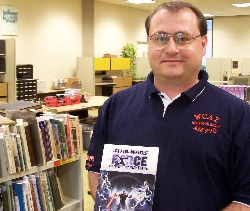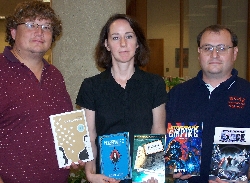University News
Graphic Novel Donation to Â鶹´«Ã½'s Malpass Library Helps Grow Special Collection
November 10, 2008
MACOMB, IL -- At , Scrooge McDuck, the Hulk, Batman and Buffy the Vampire Slayer live under the same roof as Jane Eyre, Huck Finn, Holden Caulfield and Anna Karenina. According to Greg Phelps, library specialist at Â鶹´«Ã½ Libraries, several more cartoon characters are indeed housed at the , and he and his library colleagues are doing their best to provide shelter for even more characters of the comic-book kind.
"Comic books in the library?" -- some may ask, a bit surprised. Yes, comic books in the library: in graphic novel form.
The graphic novel literature form -- defined by as "a fictional story for adults presented in comic-strip format and published as a book" -- certainly has its roots in the comic book genre. But as avid graphic novel readers know, the genre ranges from simple to complicated narratives, often embraces complex themes, at times tackles sensitive subjects and is certainly not limited to adults.
At its annual conference in Anaheim (CA) last June, the had an entire pavilion dedicated to the form, and every year, the (YALSA) compiles a "" list, which features recommended graphic novels and illustrated nonfiction for individuals ages 12–18.
"Folks often have the perception that graphic novels are just about the superheroes in comic books, but the form has expanded much further, into a huge storytelling medium," Phelps said.
With the donation of "Star Wars: The Force Unleashed," Phelps, a voracious graphic novel reader, has the earned the distinction of donating his 50th graphic novel to University Libraries' growing graphic novel collection.
"Currently, we have close to 200 books in this collection," noted Phelps. "We have various titles, and we keep a close eye on Eisner Award winners so we can keep up with the latest and greatest."
The -- named for comics writer and artist Will Eisner (1917–2005), who is viewed as one of the major pioneers in establishing the graphic novel form -- are bestowed annually at the in San Diego (CA).
Not Just a Novelty
"'' and ',' the professional journals, were reporting about how the graphic novel genre provided a great way for us to attract students and foster greater interest in reading overall," Phelps explained. "So we started the graphic novel collection about three years ago. We received a grant from the (CARLI) and that helped us get started."
Still a rather small -- but growing -- group of books, the graphic novel collection at Malpass, noted Jeffery Darensbourg, marketing and outreach librarian, is important because the library's role is one to provide material with which people want to engage.
"We collect things that people want to read, things people will use in their teaching and studies here," he said. "Graphic novels are taught at Â鶹´«Ã½, and students and faculty like to read these, so we're going to have these materials."
Although Â鶹´«Ã½'s doesn't currently offer a dedicated graphic novel course, graphic novels are taught in a variety of courses, noted Christopher Morrow, assistant professor in the English and journalism department. Morrow and his English and journalism department colleague, Assistant Professor Penny Kelsey, are among faculty members utilizing graphic novels in their classes.
"I've been using '' [by Marjane Satrapi] in English/Women's Studies 301: Women and Literature," said Kelsey. "Even before I knew a film based on the graphic novel was being produced, I thought it would be a fun text to use. I also think using this book is a good way to make women's issues -- particularly, the issues of women in the Middle East – a bit more accessible to students."
Described by the publisher, Pantheon Graphic Novels, as "Satrapi's wise, funny and heartbreaking memoir of growing up in Iran during the Islamic Revolution…['Persepolis' uses] powerful black-and-white comic strip images [to tell] the story of her life in Tehran from ages six to fourteen, years that saw the overthrow of the Shah's regime, the triumph of the Islamic Revolution and the devastating effects of war with Iraq."
Morrow noted he is using the graphic novel form in an honors course he is teaching this semester.
"The course is an examination of technology and humanity, and we're doing that by looking at the concept of cyborgs in literature," Morrow said. "Superheroes are a great source for that, so we have read two graphic novels -- one in the Iron Man continuity, "Iron Man: Extremis," which is the classic superhero novel, and the other one, 'WE3,' is kind of a send up of Disney's 'Homeward Bound.' In it, three domesticated animals have escaped a military research facility."
For more information about, or to donate to, Malpass Library's graphic novel collection, contact Phelps at (309) 298-2730 or GW-Phelps@wiu.edu.
Posted By: Teresa Koltzenburg (Â鶹´«Ã½News@wiu.edu)
Office of University Communications & Marketing



Connect with us: